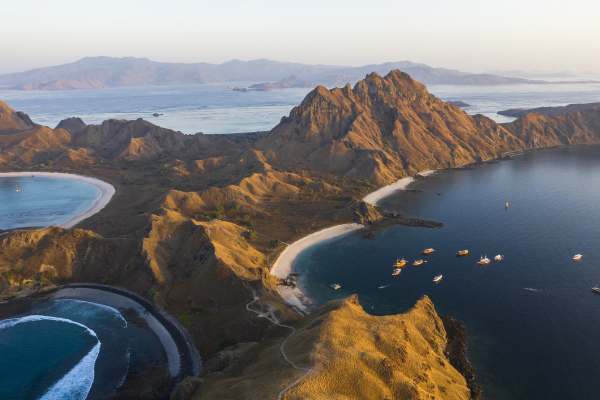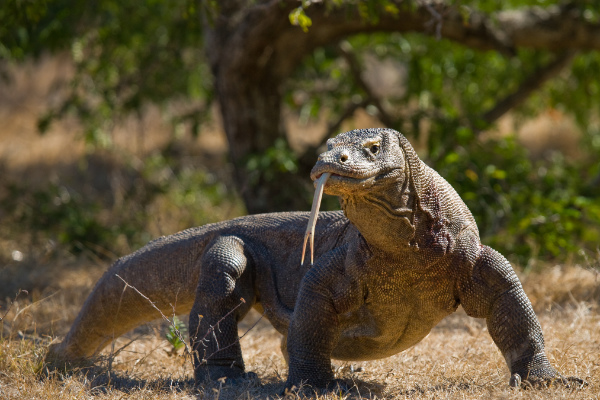Not to be confused with the fire-breathing, winged variety, the Komodo dragon is a real-life force to be reckoned with. A creature that wouldn’t look out of place in Jurassic Park, the Komodo dragon, or Komodo monitor, was first documented in 1910. But don’t let its prehistoric persona lull you into a false sense of security: the Komodo dragon is anything but primitive. To learn more about this fascinating species, read on to discover our list of the top seven Komodo dragon facts…
1. Food chain champions
2. Largest lizards
3. Killing machines
4. Heightened senses
5. Harmonious habitats
6. Reproduction rituals
7. Critical conservation
1.
Food chain champions
Along with the likes of killer whales, grizzly bears and lions, the Komodo dragon has no natural predators in the wild. These apex predators dominate their ecosystem and inspire fear among smaller animals. The carnivorous Komodo dragon isn’t a fussy eater, with meals consisting of everything from carrion to deer, and even huge water buffalo. Smaller, young Komodo dragons are also known to tempt their elders into cannibalism. How’s that for a fact about Komodo dragons? Considering a Komodo dragon can eat up to 80% of its body weight, all in one sitting, such ferocity doesn’t come as a surprise.
2.
Largest lizards
Komodo dragons take the top spot as the largest living lizards in the world. The primeval beast can measure up to a whopping 20ft long and weigh up to 300 pounds. Incredibly, the reptiles never stop growing in length or weight throughout their lives. With a lifespan of up to 30 years old, we can only imagine how huge these reptiles become. Coupled with thick armoured skin and powerful tails measuring their entire body length, it’s easy to see why they sit at the top of the food chain.
3.
Killing machines
A list of Komodo dragon facts wouldn’t be complete without mentioning the reptile’s killing prowess. Hunting prey using their razor-like, serrated teeth and sharp claws, Komodo dragons can run at a surprisingly fast speed of 12mph. After catching their food, a bite from the reptile excretes a deadly venom to quicken blood loss and release toxic proteins. Inducing shock in the animal, the dragon’s prey will meet a quick end. On the cheerier side, human fatalities at the hands of a dragon are a pretty rare occurrence, with only four recorded deaths since the 1970s. Still, we wouldn’t recommend getting too close to one, just in case.
4.
Heightened senses
Here’s another fun (or scary) fact about Komodo dragons to sink your teeth into. Did you know that dragons can smell prey from up to an astonishing five miles away? This exceptional sense of smell is thanks to a special sensory organ which allows them to precisely locate their next meal. If this happens to be on a neighbouring island, Komodo dragons aren’t fazed by swimming miles for a meal; on land or sea, the Komodo dragon reigns supreme.
5.
Harmonious habitats
Living up to the lizard stereotype, Komodo dragons love hot climates. Beyond populating the Indonesian island of their namesake, Komodo, the species are also endemic to the Lesser Sunda islands of Padar and Rinca, alongside several smaller islands. These lush, tropical islands are of volcanic origin, sitting within the biodiverse Coral Triangle and forming the Komodo National Park. Established in 1980 to preserve the species and its habitat, this 700sqm protected area allows lizard royalty to freely roam their island kingdom.

6.
Reproduction rituals
The feisty female Komodo dragon has the evolutionary advantage of reproducing both sexually and asexually. In nature, dragons mate just once a year, with females laying up to 30 eggs at a time. Largely occurring in captivity, asexual reproduction happens in a process called ‘parthenogenesis’. This skill does have a downside, however. Solely producing males, asexual reproduction risks a dwindling female dragon population, leaving the species at a greater risk of endangerment.
7.
Critical conservation
Rounding off the list is this sobering Komodo dragon fact: as of 2021, our favourite giant lizards have become an endangered species. Rising sea levels and human activities such as poaching and destruction of habitat pose a great threat to their survival. Given their small geographic range and the fact that not all hatchlings survive into adulthood, their levels are expected to decline further. Luckily, populations remain stable in the UNESCO World Heritage site, the Komodo National Park, which provides an important economic boost for protection initiatives.
Written by Hannah Whitehall

